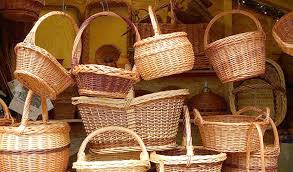Gundipora: Tradition in Every Thread
Beyond wicker mastery, the poetic legacy of Sufi poets and the contemporary musical sensations echoing from this South Kashmir gem reveal a multifaceted artistry that defines Gundipora's unique identity.
By Rayees Ahmad Kumar
Several days prior, a multitude of social media pages and groups drew attention to the remarkable artistic prowess flourishing in the idyllic village of Okai, nestled in the heart of South Kashmir’s Kulgam district. This village, situated proximate to the bustling town of Kulgam, has gained widespread acclaim for its expert craftsmanship in the intricate art of Kangri manufacturing. In the unforgiving embrace of winter’s coldest and harshest days, when the absence of electricity renders every electronic device ineffective against the bone-chilling cold due to frequent power outages, the centuries-old traditional Kangri emerges as our savior. In the face of the relentless chill of chillaikalan, locals have long entrusted their well-being to this earthen pot intricately woven with wicker and filled with hot embers. Worn beneath their traditional clothing, the pheran, the Kangri not only serves as a means to ward off the biting cold but is also revered as a true work of art.
The tales of Okai village’s artistic prowess transcended the virtual realm of social media, extending their reach to the tangible pages of print and electronic media, thereby propelling the village into the global spotlight. Inspired by these narratives prominently featured in valley-based dailies, I felt compelled to cast a spotlight on Gundipora, a village in the same district. This settlement, positioned on both sides of the Kulgam-Qazigund stretch of NH 444, stands approximately six kilometers from Qazigund and nine kilometers from Kulgam town. As an integral part of my domicile panchayat village and neighboring Wubber, Gundipora has distinguished itself for not only its Kangri and basket weaving but also a myriad of other traditions and art forms.

The inhabitants of Gundipora, characterized by their benevolence and selflessness, predominantly engage in non-agricultural activities, with only a few owning more than a couple of kanals of land. However, their golden hands are bestowed with exceptional skill in wickerwork. Annually producing thousands of Kangris and wicker baskets, the village has become synonymous with these enchanting artifacts, celebrated not only in nearby villages but throughout South Kashmir for their captivating aesthetics and reasonable prices.
During mid-chillaikalan, when the entire valley is blanketed in snow, these skilled artisans traverse from village to village, expertly repairing Kangris in people’s homes. Wickerwork stands as the primary occupation in this cherished hamlet, providing sustenance to its residents. In the months of September and October, neighboring village dwellers flock to Gundipora to acquire Kangris for their families before the onset of winter.
Beyond its mastery in wickerwork, Gundipora boasts cultural significance for a multitude of reasons. The land has given birth to a cadre of distinguished Sufi and mystic poets, whose poetic brilliance resonates within literary circles. One such luminary is Gh Hassan Gundpori, a prominent Sufi poet known for composing hundreds of Sufi songs and manqabats dedicated to revered saints of the valley. His manqabat of Syed Hussain Simnani ra stands as a masterpiece, reflecting his poetic prowess and spiritual beliefs. A posthumously published collection of his poetry has garnered recognition and acclaim from a broad readership.
Gundipora’s cultural richness extends to its musical contributions, as it has produced a cadre of talented vocalists whose melodious voices echo not only in local events but also on Radio Kashmir Srinagar and Doordarshan Kendra stations. From my childhood, I reminisce about the famous lyrical song of Sufi poet Niyama sahib, “poshai laghou wa zailie lo,” sung by Abdul Salam Gundpori, an eminent singer from the village, airing on Radio Kashmir’s Yiwawani service at night. In contemporary times, Yaseen Gundpori has gained widespread recognition with his soulful rendition of Samad Mir’s prominent song “Padh Padh ke Gaya pathar likh likh ke Gaya chour,” accompanied by fellow villagers playing a terracotta pitcher and a violin.
Aijaz Hassan Gundpori, a central figure in the village’s musical landscape, is the beloved son of the late Gh Hassan Gundpori. His YouTube channel features hundreds of Sufi and folk music songs that have garnered substantial attention on social media platforms. Aijaz, following in his father’s footsteps, not only vocalizes but also composes lyrics, with his popular song “Mei kormut khudayan sayi dilbaro, che chai pata lael gesa zaya dilbaro” becoming a staple in wedding ceremonies and cultural events. His artistic prowess and poetic legacy seem to be a hereditary gift.
Bilal Gundpori, another noteworthy artist from Gundipora, has captured acclaim on social media with his mellifluous song “Zarum na doorer khuda gawah chum.” This budding talent is making waves in the artistic landscape of the region. The village is also home to the humorous and satirical Ab Gani Bhat, fondly known as Nyama Kak, who not only excels in playing the flute and indigenous dance but also serenades audiences with Ladakhi songs in enchanting tunes. As a Kangri and wicker basket artisan, he entices customers with splendid artistic performances when selling his handicraft items in local areas.

In a concerted effort to preserve the rich art and legacy passed down by their fathers and forefathers, the youth of Gundipora have embraced poetry and singing. Nearly every young boy and girl in the village possesses an innate talent for singing or poetry, affirming the belief that the land itself is divinely fertile for art and literature. Each individual who ventures into these artistic fields shines like a midnight star. It is rightly said that the essence of a nation resides in its culture and traditions, and the people of Gundipora have taken a solemn pledge to safeguard their heritage from erosion, ensuring its recognition on the global stage for generations to come.

Comments are closed.